What to do in Cordoba Spain
Attractions, Food and Tips
Sitting in the fast train from Madrid to Cordoba, we were exhausted after a night without sleep but even though all we wanted to do was to close our eyes, soon enough we started noticing the views; patches of olive groves and leafy green carpets flew before our eyes, the sun was warming our faces and we could feel the excitement slowly overcoming our fatigue while we were thinking about all the things to do in Cordoba.
The minute we stepped down from the train, we were greeted with the harsh unapologetic August sun of Andalusia and that was the moment we finally understood why the Spanish insisted on having their siesta, it was too damn hot! Visiting Cordoba in the month of August is not ideal but there are ways to overcome the almost unbearable heat so you’d actually get to enjoy all of Cordoba’s attractions. First tip? explore Cordoba in the morning and the afternoon and take a break at the hotel’s pool (sipping a cold sangria of course) during the hottest hours – Siesta it is!
By now you probably know that Spain is one of our favorite destinations. We especially love the picturesque cities and towns of Andalusia and Cordoba is one of the most beautiful and interesting towns in the area with so many things to do. The old curvy alleys and magnificent architecture and landmarks hold the key to Cordoba’s charm and tell the story of Spain’s golden age when Jews, Muslims and Christians lived together in harmony. The town is quite small and when taking into account the foodie scene and laid back atmosphere, Cordoba is the perfect destination for a weekend getaway in Spain. So if you are asking yourselves what to do in Cordoba, here is the perfect city guide.
This post may contain affiliate links, which means we earn a small commission if you purchase from them (no extra costs to you!). For details check our disclaimer.
Table of Contents
Get our FREE Maps-2-Go
Get monthly updatesincluding exclusive access to our google maps which feature all of our favorite attractions in numerous cities all over the world.
I want to subscribe to your NEWSLETTER!
What to Do in Cordoba - Attractions and Tips
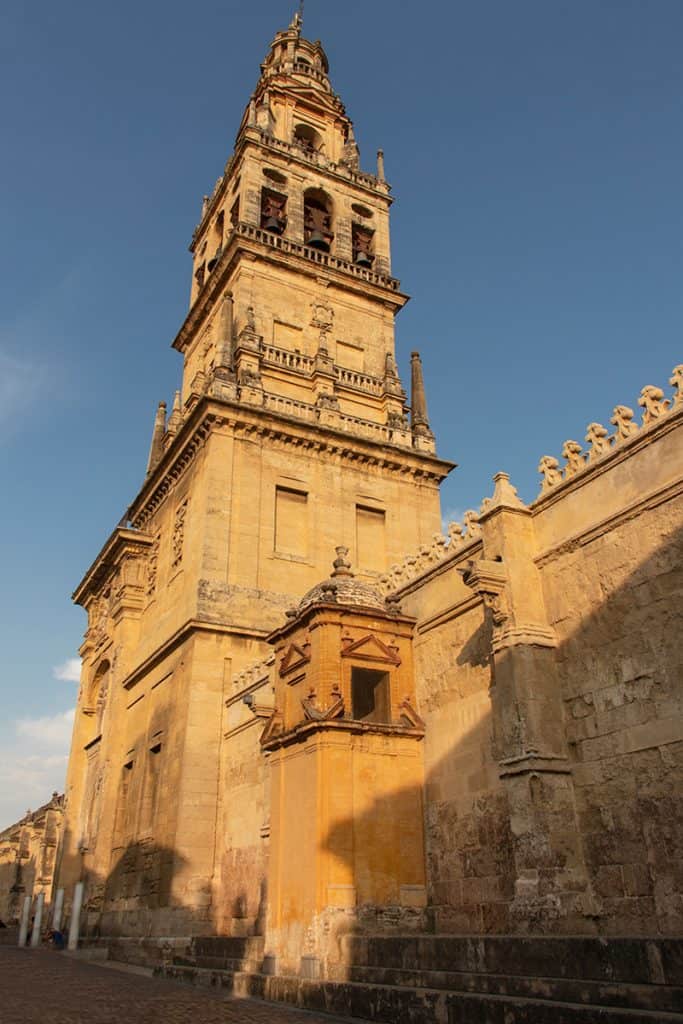
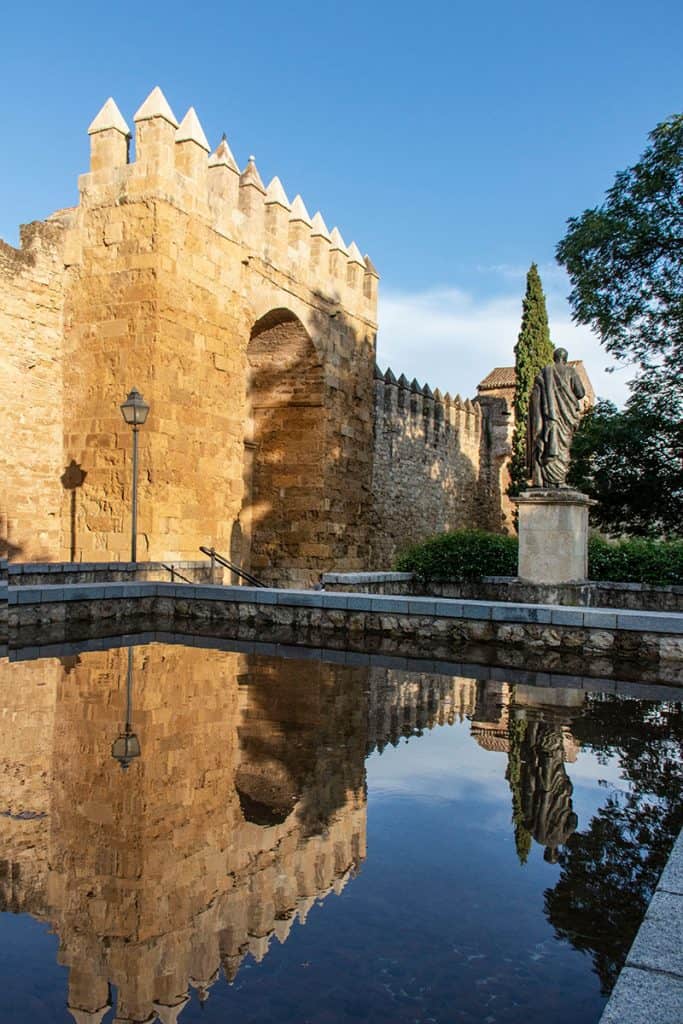
When is the best time to visit Cordoba?
Before we actually talk about what to do in Cordoba, let’s talk about the weather. The ideal time to visit Cordoba must be during fall or springtime when the temperatures are pleasant, and the humidity is under control, however if you do visit the area during the summer hot months, just embrace the local siesta and laid back atmosphere. Rest at the hotel’s pool during the hottest hours of the day and start exploring the city again in the afternoon till the wee hours of the night, like the locals do (dinner time is after 9 PM).
If you are lucky enough to visit the area during the spring there will so many things to do on top of the regular attractions of Cordoba. From the end of April, all through May there are celebrations all over Cordoba, starting with “Battle of the Flowers” during which the women dress in gypsy garbs, singing traditional songs and riding through the town’s streets on decorated floats. Then it’s time for the procession of the “blooming” crosses which are decorated with colorful flowers, followed by the “Patios Festival” when the owners of the most beautiful patios in town open their houses for visitors and finally for the crescendo it’s time for “Spring Fair”.
So as you can see, the Spanish really love their spring celebrations, and during this season the city turns into a colorful carnival, with lots of special events, trays of tapas, glasses of sangria and traditional flamenco shows all over the city. For more information read this article about the Spring festivals and attractions.
How to Get to Cordoba?
The nearest airports are in Seville, Malaga or Madrid and from there the easiest way to get to Cordoba would be by train or car. If you are planning to visit several locations in Andalusia, then rent a car, though be aware that it might be hard to find parking, especially in the historic center. Search for hotels with free (or paid) parking. By train, it will be easy and convenient to get to Cordoba. It will take you about 2 hours from Madrid (with the fast train) and 45 minutes from Seville.
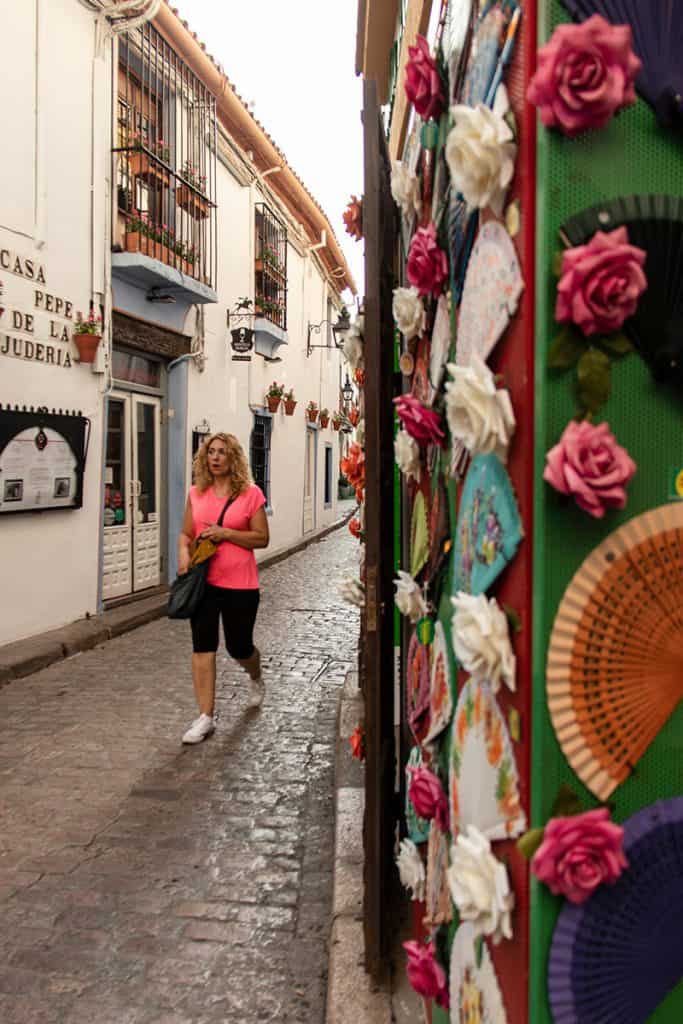
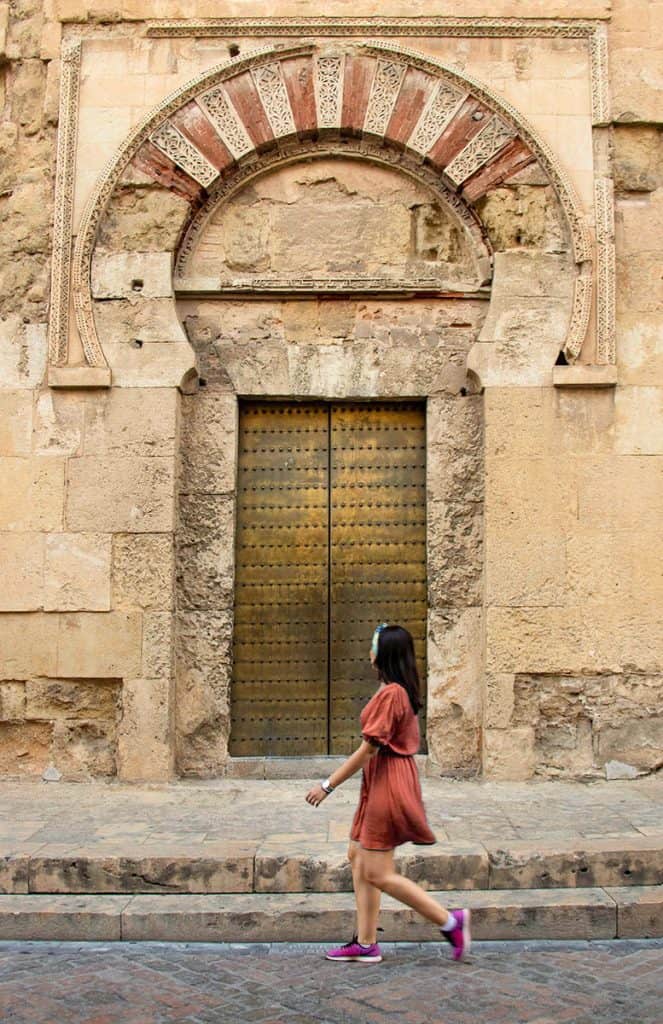
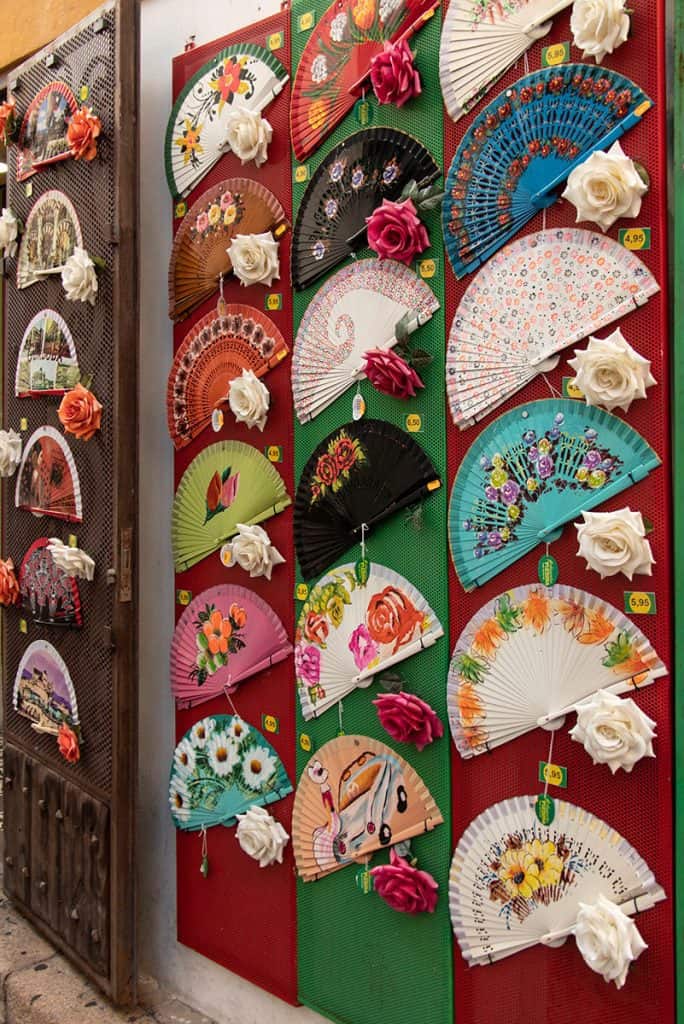
What to Do in Cordoba
Historic Center of Cordoba and UNESCO Sites
Did you know that in Cordoba you can find more UNESCO World Heritage Sites than in any other city in the world? Therefore, this should be your first item on your list of things to do in Cordoba. Exploring Cordoba’s historic center is one of the best things to do in the city. The historic center itself is a part of UNESCO list and here you’ll find most of the attractions Cordoba has to offer. There are so many magnificent historic landmarks hidden amongst the labyrinth of old white-coloured alleys. Behind every turn there’s another blooming patio or a beautiful shop, not to mention the abundance of traditional tapas bars and cosy coffee shops. As always, our best tip is to just start walking and find these little gems that are just waiting to be discovered. Here are some of the must-see attractions in Cordoba’s historic center:
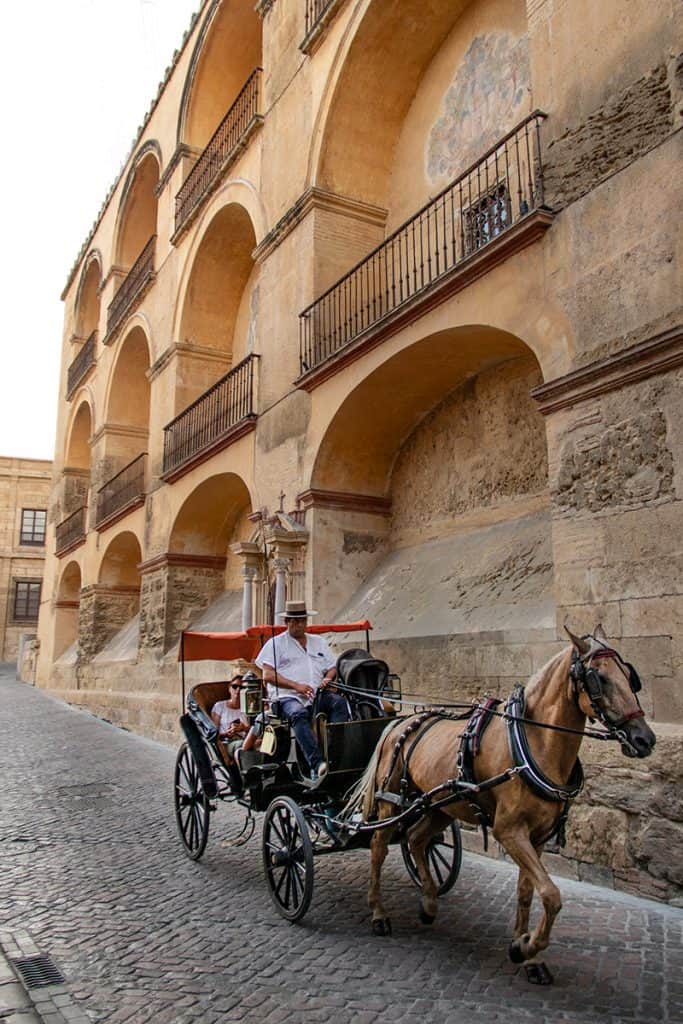
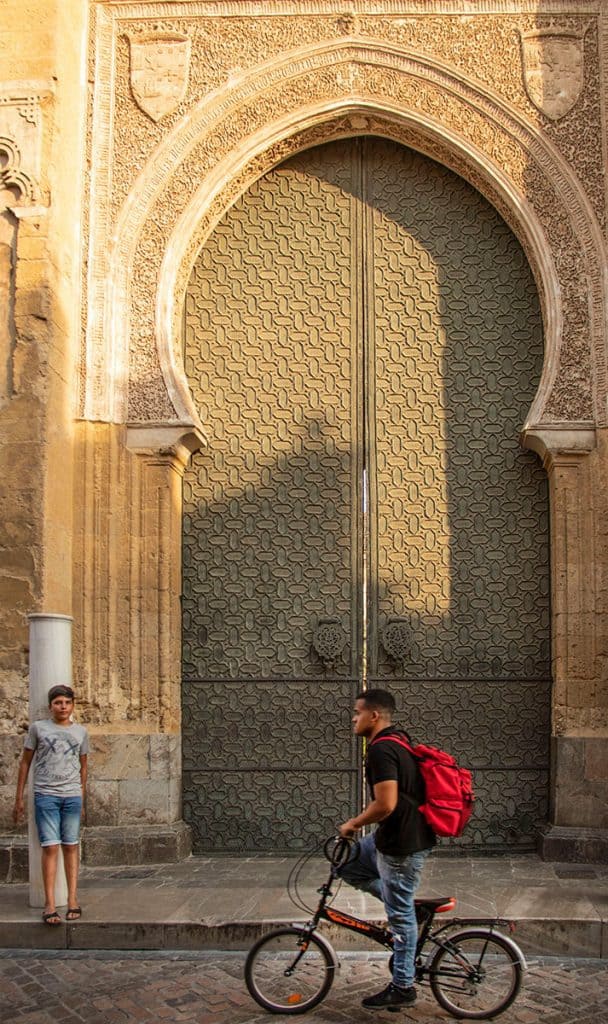
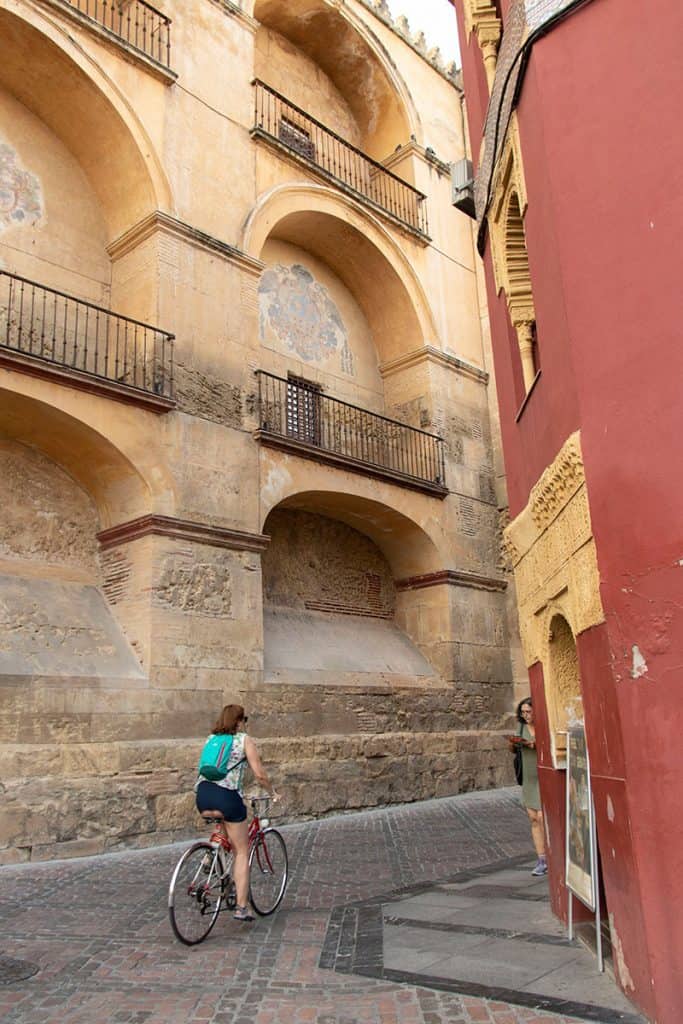
Visit the Most Famous Attraction in Cordoba - Mezquita
One of the most important attractions in Cordoba is the old Mosque at the heart of the historic center that nowadays is used as a cathedral. It is one of the most extravagant buildings in Spain which was built by the Muslims in the 8th century and was awarded a UNESCO World Heritage Site status in 1984. Enter through the impressive bronze doors and follow the path to the inner courtyard with its lovely orange trees, from there you can make your way to the remarkable inner space of the mosque. The sight of the ribbed dome and the dozens red and white arches is a memorable sight that is a prime example of some of the best Moorish architecture that can be found in Spain.
Tip: The best time to visit the Mezquita is very early in the morning. On Mondays – Saturdays individuals can enter the compound for free between 8:30 to 9:30 (there’s a one hour limit on your visit). The tower is opened at 9:30. If you like’d the place to yourself without organized groups and many tourists around, this is the best time to visit. Another great option is to purchase tickets for the night visit, which includes a guided tour during which you’ll get to see the different halls illuminated beautifully, however you are not allowed to take pictures during this tour. Don’t forget to book your tickets in advance since these night tours are very popular.
Prior to your visit, check that there are no special events since then the opening hours may be modified. Address: Calle Cardenal Herrero, 1, 14003 Córdoba, Spain
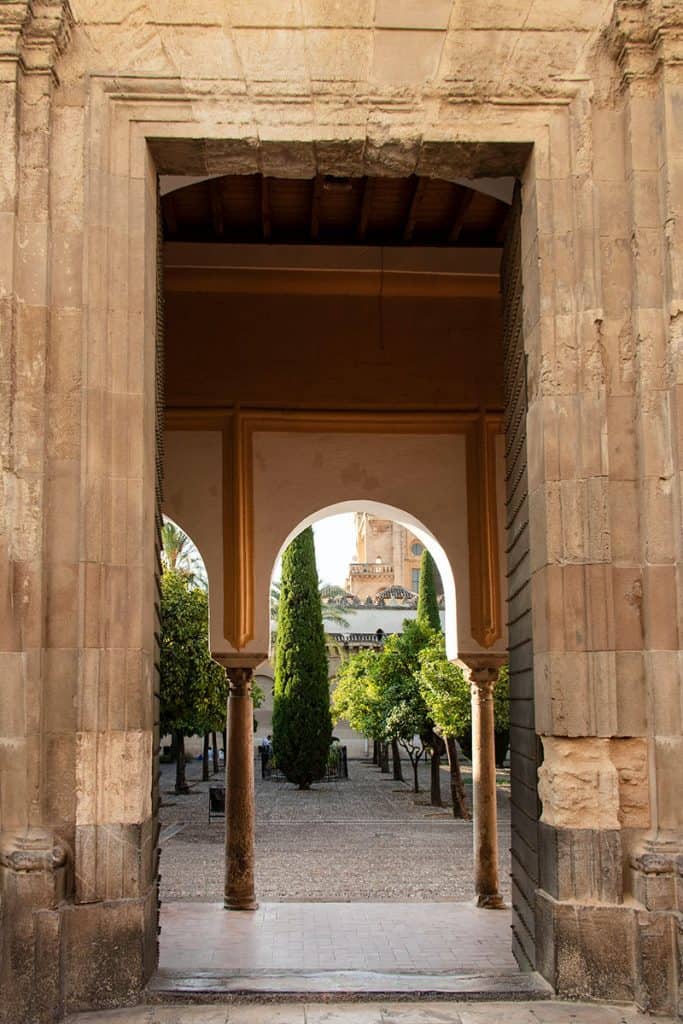
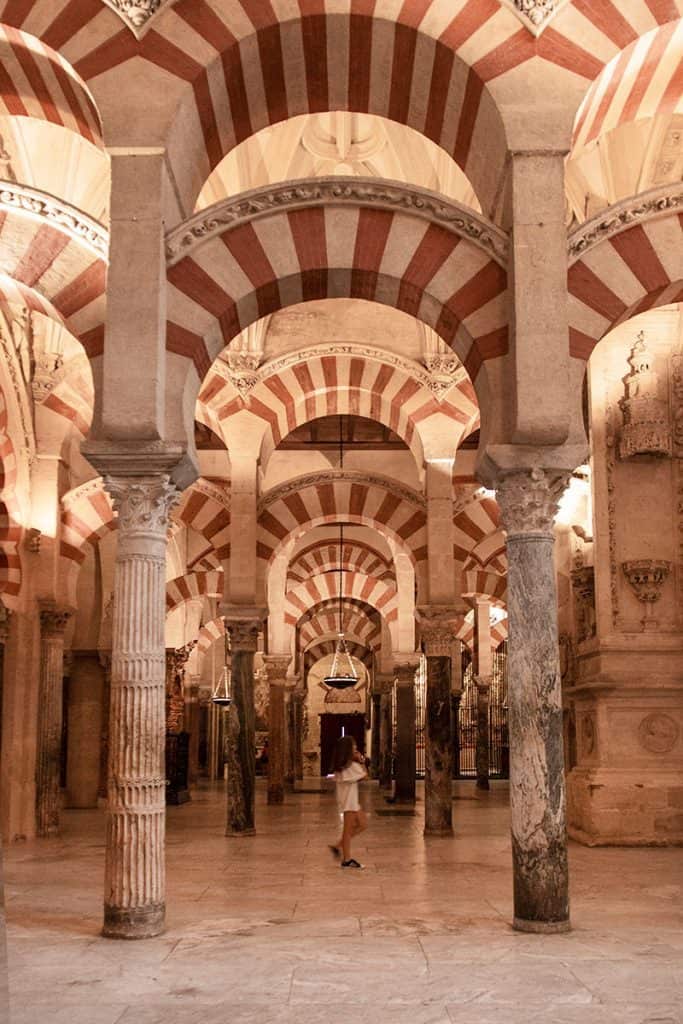
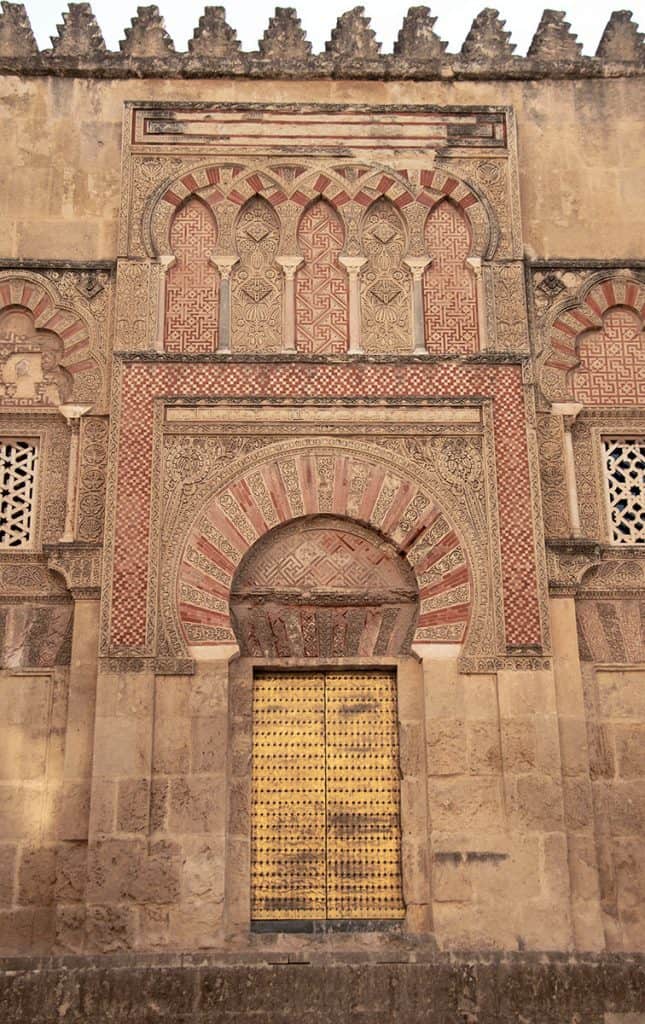
Get Lost in the Alleys of Judería (Old Jewish Quarter)
The old Jewish quarter is one of the best areas in town to get lost in and it should definitely be at the top of your things to do list. Wander along the narrow white-colored alleys which are dotted with beautiful leafy patios, charming little stores and plenty of restaurants and bars. There are many places to visit here. Here are a few of the best attractions in Juderia, Cordoba:
Synagogue of Cordoba
Anyone who loves history and architecture would enjoy visiting the ancient synagogue of Cordoba. During its long history, it used to be a place of worship, a sanctuary for Jews who fled from other countries, a school for Bible studies, a hospital., a chapel, a preschool and finally after the beautiful and intricate inscription were discovered in 1884, the synagogue was restored and nowadays it is one of the most visited attractions in Cordoba. You can read all about the history of the synagogue and learn more about the beautiful and unique inscriptions here.
Opening hours: Tuesday to Saturday: 10:00 am. to 2:00 pm and from 3:30 pm to 5:30 pm. Sundays and public holidays: 10:00 am to 2:00 pm. TicketsAdmission is free for European citizens and less than 1 Euro for others. Address: Calle Judíos, 20, 14004 Córdoba, Spain
See the monument of the famous philosopher and scholar Rabbi Moses Ben Maimon (Maimonides) at Plaza de Tiberiades. Don’t skip one of the most beautiful alleys in the area, Calleja de Las Flores (you’d better come early or it will be packed with tourists) and rest for a while at one of the coffee shops at Plaza de Juda Leví
Calleja de Las Flores
This is one of the most famous streets in Cordoba, the epitome of the Andalucian street. It’s really fun to wander through the whitewashed houses which are decorated with colourful pots filled with flowers and pants. The little alley ends in a small plaza with a beautiful view of Cordoba’s Mezquita. Address: Calleja de las Flores, 1, 14003 Córdoba, Spain. Best Tip: Come early before this charming alley is packed with tourists and don’t forget to rest for a while in the little plaza.
Chapel of San Bartolomé
Although it is relatively unknown to tourists, this small chapel which is located just near the synagogue at the Faculty of Arts building is a beautiful work of art. With a history that dates back to the end of the 14th century, this unique monument is a great example of Mudéjar art. The walls are decorated with geometric mosaic constructed from blue and greens tiles. Address: Facultad de Filosofía y Letras, Calle Averroes, S/N, 14004 Córdoba, Spain
Other Attractions in Juderia
This little neighbourhood is one of the most charming areas in Cordoba so just wander around the ancient whitewashed alleys and admire the colourful flowers and balconies. Visit the monument of the famous philosopher and scholar Rabbi Moses Ben Maimon (Maimonides) at Plaza de Tiberiades. and rest for a while at one of the coffee shops at Plaza de Juda Leví.
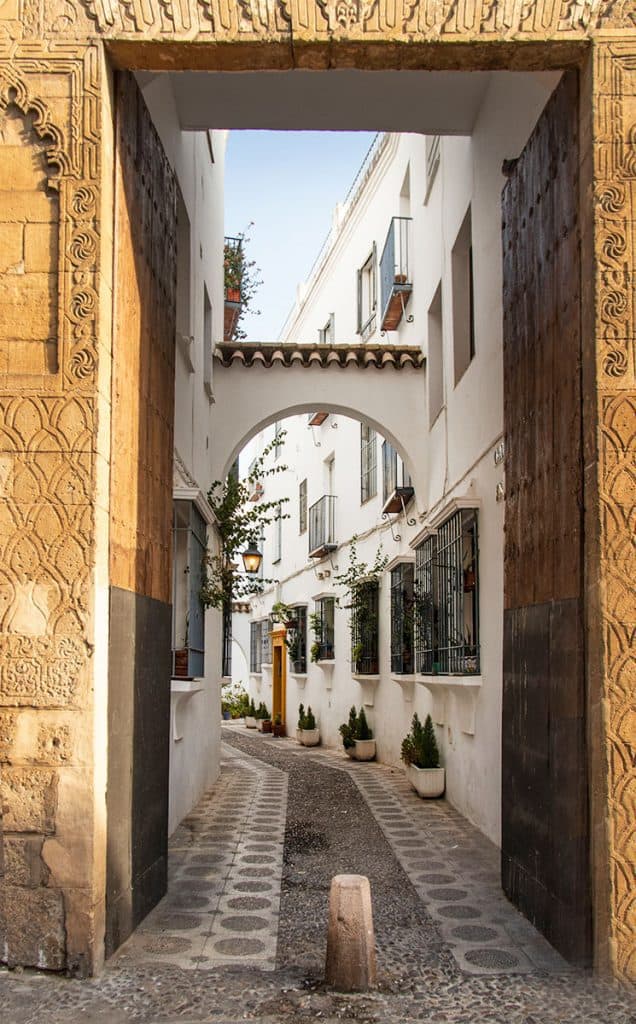
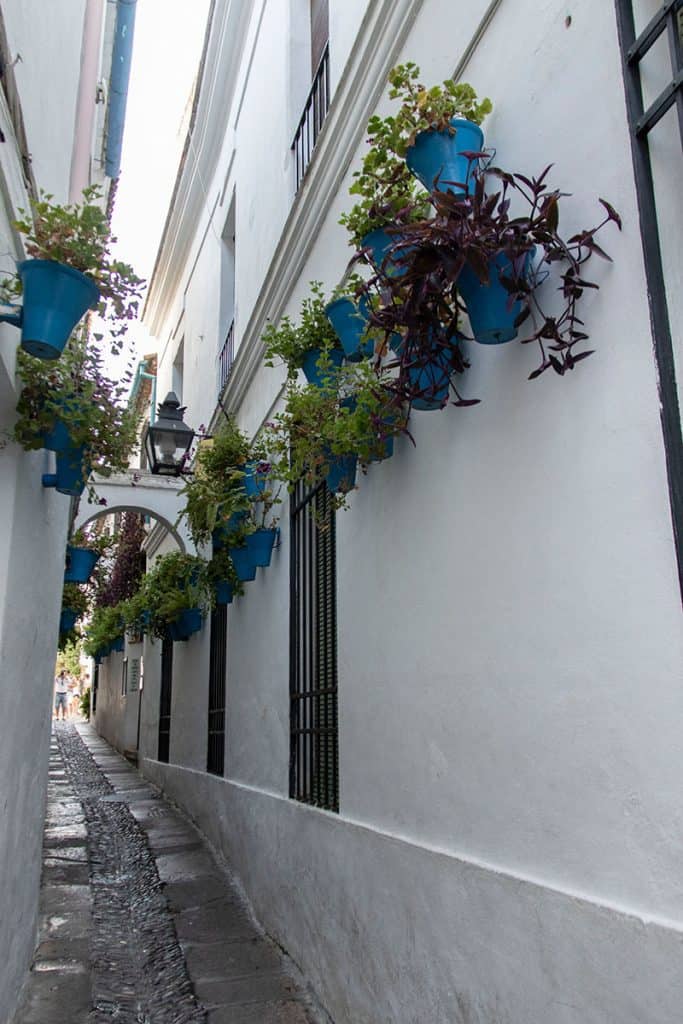
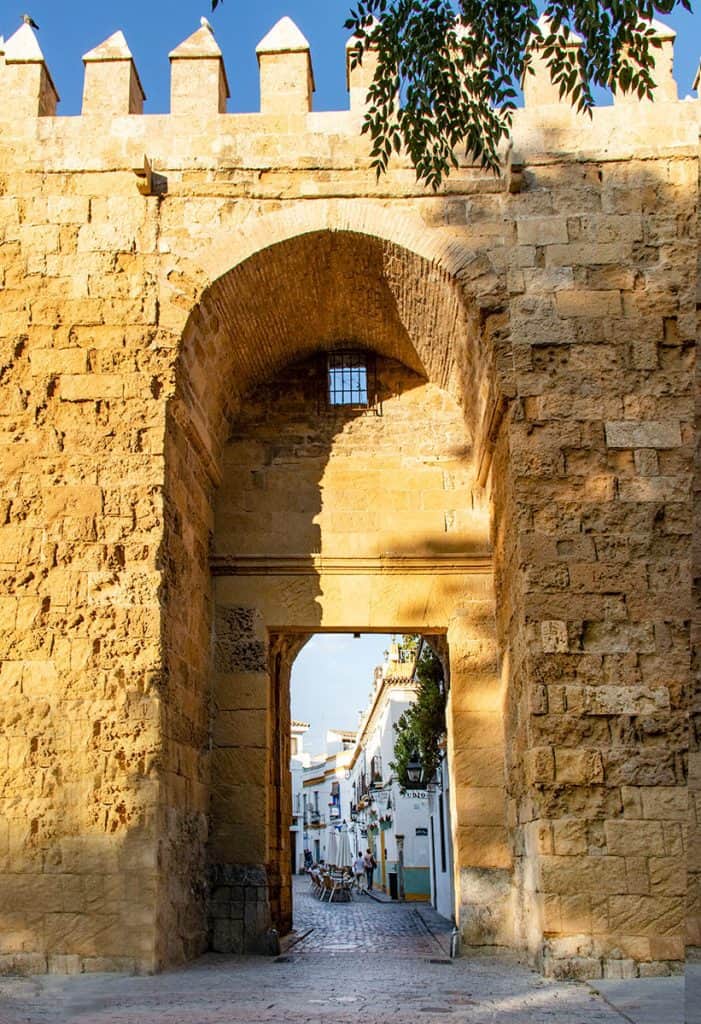
Admire the Views from Córdoba's Roman Bridge (Puente Romano)
The Roman Bridge is another historical monument in Cordoba that has had great significance over the years. Originally this impressive bridge was built in the early 1at century BC by the Roman emperor Augustus. Since then it has been reconstructed many times and its current look is the result of the Islamic reconstruction. It is almost 250 meters long and it has 16 arches. Though throughout history it played a major role in protecting the city, nowadays it’s one of the most beautiful tourist attractions in Cordoba, both during the day and during the night. In the late afternoon, Cordoba comes to life again after the sleepy hours of the siesta and the promenade along the Roman Bridge is filled with locals and tourists alike. Make your way along the crowd of ice cream sellers, local musicians, artists, local families and tourists and enjoy the spectacular view of the city and the Guadalquivir River. Address: Av. del Alcázar, s/n, 14003 Córdoba, Spain
Tip: You do need to see the bridge both in the daytime and nighttime so the perfect time would actually be as we suggested in the late afternoon so you’ll get the best of both world. A fun fact about the Roman Bridge – It actually appears in Season 5 of Game of Thrones!
The Calahorra Tower (Torre de la Calahorra)
Just across Cordoba’s historic center, you’ll find another important monument, the Calahorra Tower which is, in fact, the oldest defence building in Cordoba. Though historians have yet to agree on its origins, the most popular theory is that it was built during the Islamic time by the Moors to protect the city and later it was reconstructed. Other than its defensive purpose, throughout the years it was also used as a prison and as a school for girls but nowadays you’ll find here the museum of Al-Andalus it, a charming little museum that showcases the three cultures that helped shape Cordoba’s past: Christian, Muslim and Jewish cultures. You can cross the Roman Bridge to get to the Calahorra Tower and climb the tower to capture the magnificent panoramic views of Cordoba from the top or look at the town from a different perspective from this end of the bridge. If you are looking for a great spot to watch the sunset in Cordoba, come here, because you’ll get to see Cordoba coloured by the golden hues of the setting sun. Address: s/n Puente Romano, 14009 Córdoba, Spain. Opening hours for the tower: 10:00 am to 7:00 pm daily. Opening hours for the museum: Summer 10:00 am to 2:00 pm and 4:30 to 8:30 pm. Winter 10:00 am to 6.00 pm.
Enjoy the Splendor of Museum Palacio de Viana
This aristocratic palace is also fondly referred to as the “Patio Museum”. Each courtyard here has a different design, so wander around the gorgeous inner patios through the plethora of plants, flowers and decorated fountains. In some of the patios you’ll see pinkish bougainvillea, in others palm fronds or citrus trees but they are all equally impressive and provide a glimpse into the lives of the old Spanish royalty. You can easily spend here an hour or two so bring your camera and enjoy the relaxing atmosphere. Here is the full list of patios and courtyard as well as the opening hours. Address: Plaza de Don Gome, 2, 14001 Córdoba, Spain
Tip: On Wednesdays, the entrance is free from 2:00 to 5:00 pm (limited access).
Go on a Patio Treasure Hunt
Due to the hot weather conditions in Andalusía, the local houses were built around an inner courtyard, a patio. This tradition dates back to the Roman times and is preserved till this day. The local residents are very proud of their beautiful groomed patios and they fill them with leafy plants, colorful flowers, fountains and more to preserve the cool atmosphere. As mentioned before, if you happen to visit Cordoba in May you’ll also get to enter some of the courtyards whose owners compete in the “Patios Festival” (most of them are usually locked behind decorated gates). Then you’ll really have a chance to appreciate the details of the mosaic art, sculptured fountains and sculptures that can be found in these patios. One of the best neighborhoods to visit during this contest in San Basilio, for more details check out this article about the attractions and things to do during the festival.
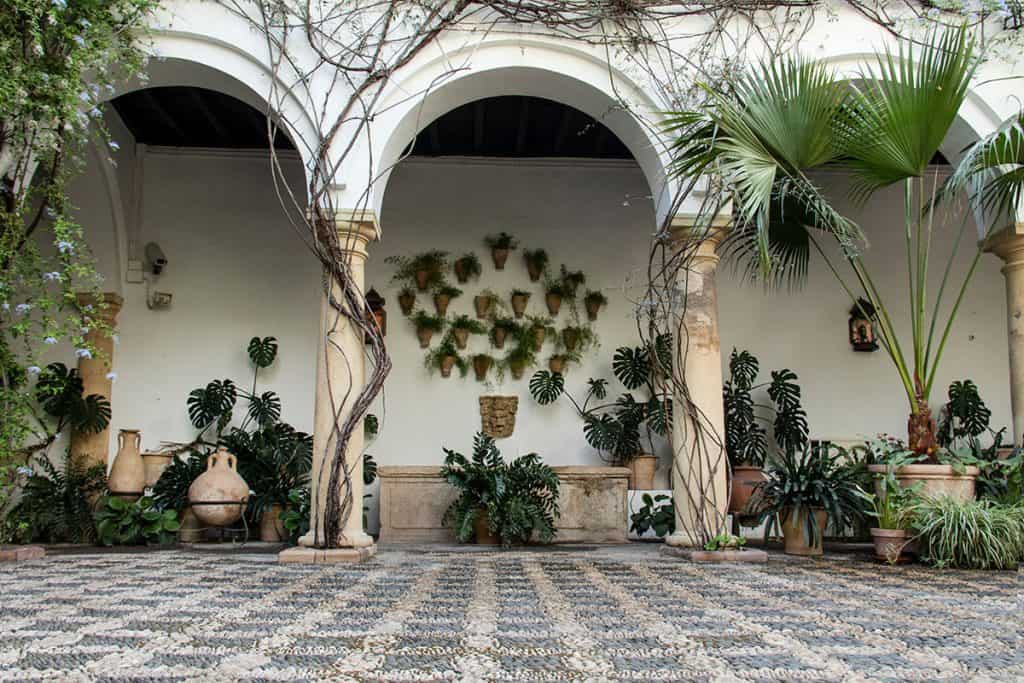
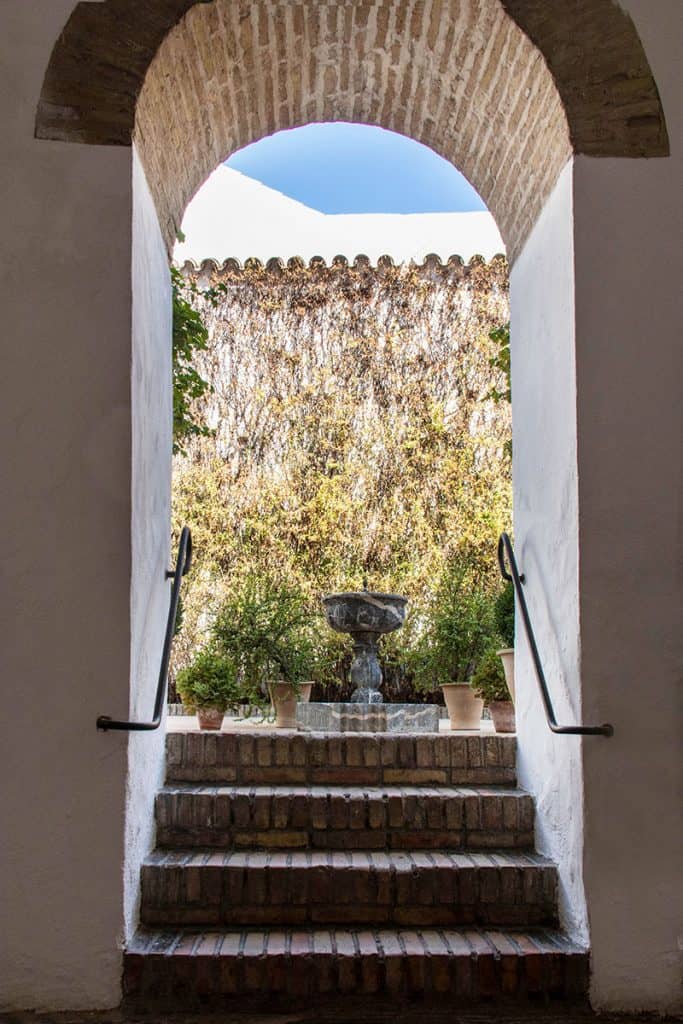
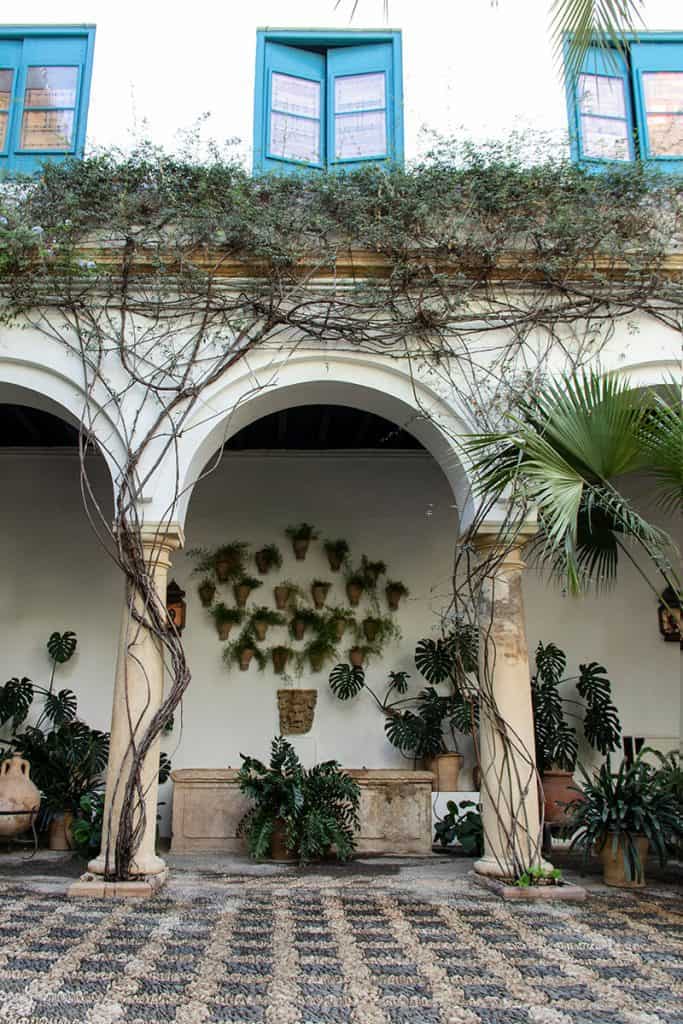
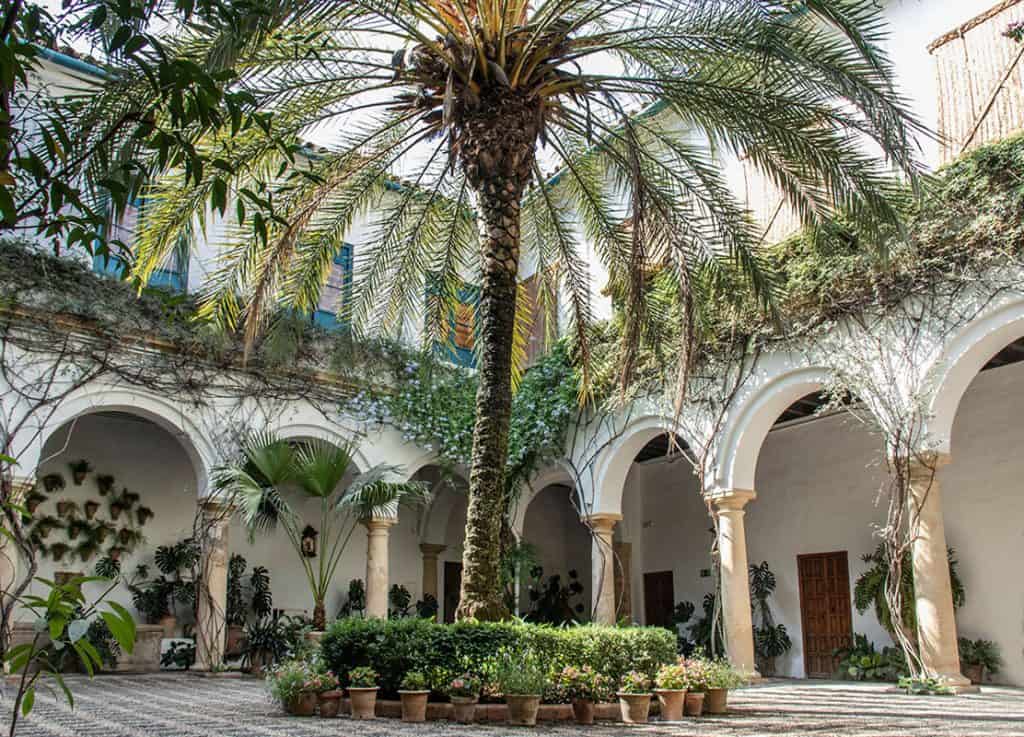
Explore Alcázar de los Reyes Cristianos
The Castle of the Christian Monarchs was built by Alfonso XI in 1328 and served through the years as the place of residence of the rulers of Spain (the most famous ones are probably Isabella I of Castile and her husband, Ferdinand, who even met with Christopher Columbus here, as he was preparing to embark on his famous voyage to the Americas). The outdoor area of this fortress/castle is within the walls of the four towers from where you can admire the magnificent views of the city. While exploring Alcázar de los Reyes Cristianos the impressive walls and mosaic decorated halls provide a glimpse into the lavish lifestyle of Spanish royalty, but the most interesting part of this compound, in our opinion, is the beautiful gardens which provide thousands of opportunities to get the perfect Instagram shot.
Other Attractions and Things to Do in Cordoba
If you have more than just 36 hours, Cordoba has some other interesting attractions and things to do for your itinerary.
Visit Cordoba's Museums
There’s a great selection of interesting museums in Cordoba that you can add to your itinerary:
Museo de Bellas Artes – The Museum of Fine Arts is perfect for art lovers and it is located at Plaza del Porto at a building that was once a hospital. In was first opened in 1862 but in 1936 it was renovated in the Renaissance style. You’ll find here paintings by artists from the Renaissance, the Baroque and the 19th century. Don’t forget to take a peek at the lovely little courtyard with citrus trees. Address: Plaza del Potro, 1, 14002 Córdoba, Spain (closed on Mondays).
Museo Julio Romero de Torres – Located just next door to the Museum of Fine arts, in Museo Julio Romero de Torres this former church, you’ll find a selection of the paintings and personal items of Julio Romero de Torres who is considered as one of Spain greatest painters. There are also other paintings on display from Baroque, and Renaissance painters as well as some other contemporary painters. Address: Plaza del Potro, 1, 14002 Córdoba, Spain. (closed on Mondays)
Casa Ramón García Romero – This unique museum is perfect for anyone who loves arts and crafts. Here you’ll be able to admire the craftsmanship of working with embossed leather that is typical for Cordoba. Ramón García Romero has revived this ancient technique of decorative leatherwork that was used by 10th-century Umayyad artisans. These intricate work of arts are displayed in five different rooms. Address: Plaza Agrupación de Cofradías, 2, 14003 Córdoba, Spain. (closed on Sundays).
Iglesia de San Miguel and Iglesia de San Lorenzo
If you enjoy visiting churches then both San Miguel and San Lorenzo are worth a visit. Both of these churches were built under the orders of King Ferdinand III of Castile, as part of a series of churches intended to repopulate the city with Christians. Most of these churches were actually renovations of former mosques. Iglesia de San Miguel has some Romanesque and Gothic elements, the entrance is free but you can only enter it before or after a service. San Lorenzo has some lovely murals and a bell tower.
Madinat al-Zahra
This medieval palace (or rather town – medina) was built by the Caliph Abderramán III in an effort to demonstrate his powers. According to the legend it was named after his favourite wife, Azahara. The construction started in 936 and lasted for several years but everything was destroyed around 1010. This town was rediscovered only in the 20th century and nowadays, it is considered as the most extensive Islamic archaeological sites in Western Europe where the excavation processes still continue. Recently it was recognized as a UNESCO World Heritage Site. Most of the city is still. Madinat al-Zahra is actually located about 8 km from Cordoba and you can get there by car or public transprtation. For more details chech their site.
What to eat in Cordoba?
By now you are well familiar with the traditional patios and historical landmarks of the city but another aspect of the Andalusian culture, and just as important, is the great food scene. So add these best dishes of the Andalusian cuisine to your things to do list:
Gazpacho: If you happen to visit Cordoba during the hot summer months, and you are looking for something refreshing to cool you down, try the local Gazpacho – well-seasoned cold tomato soup. You can also try the thicker version, a specialty of Cordoba, the Salmorejo, either in the tomato version or the lovely purple colored beet version.
Ajo Blanco – The white gazpacho of Cordoba – almond and garlic cold soup with a thick consistency which is usually served with a sweet fruit such as grapes.
Fish and other seafood – Seafood is a great choice for meals in Cordoba, especially the way the locals eat them: fresh or fried and crunchy. You must try the fresh anchovies which are a true delicacy and served on toasted bread with a splash of olive oil.
Stews: If you are fans of rich stews, try the famous oxtail stew, one of the most popular stews in the area. You can also try the various boar stews or the local couscous.
Churros: Everyone has their favorite version of churros and the Spanish eat theirs accompanied by a large cup of melted chocolate, we told you they know how to enjoy life! Churro bars are scattered all over town and even if you are not a fan of this fried donut, you do need to have a taste, at least once, of these little bites of pure joy, served warm and crunchy. Even though we usually don’t eat a lot of sweets, we devoured these little suckers in an instant.
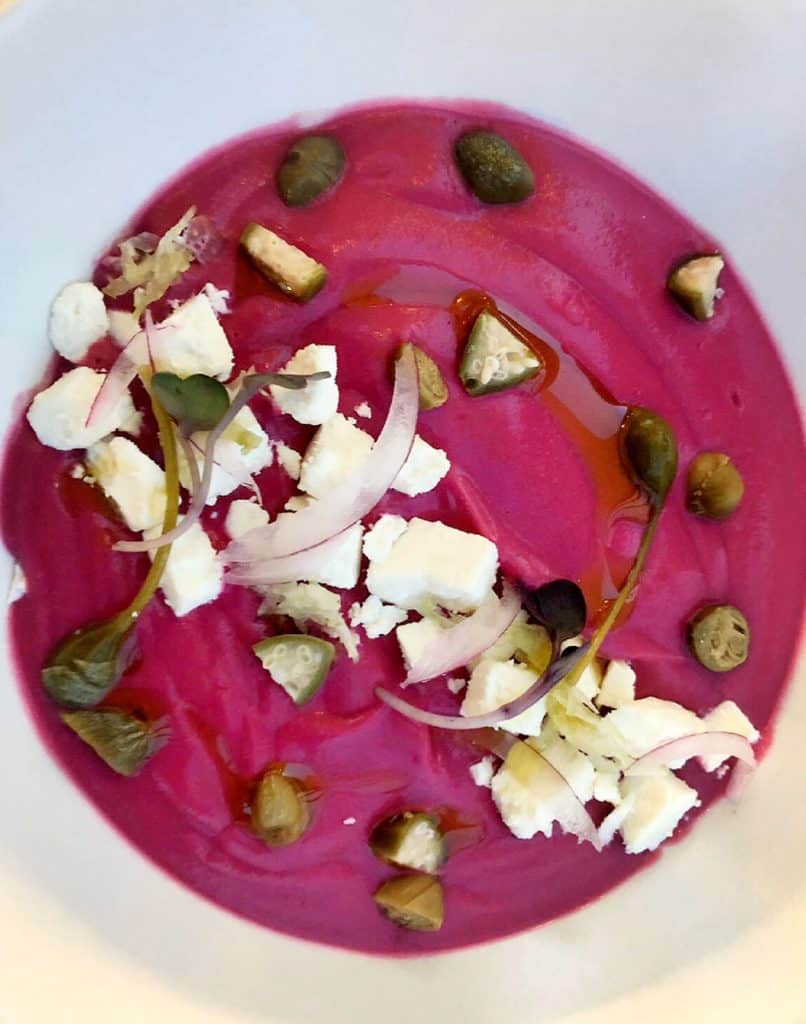
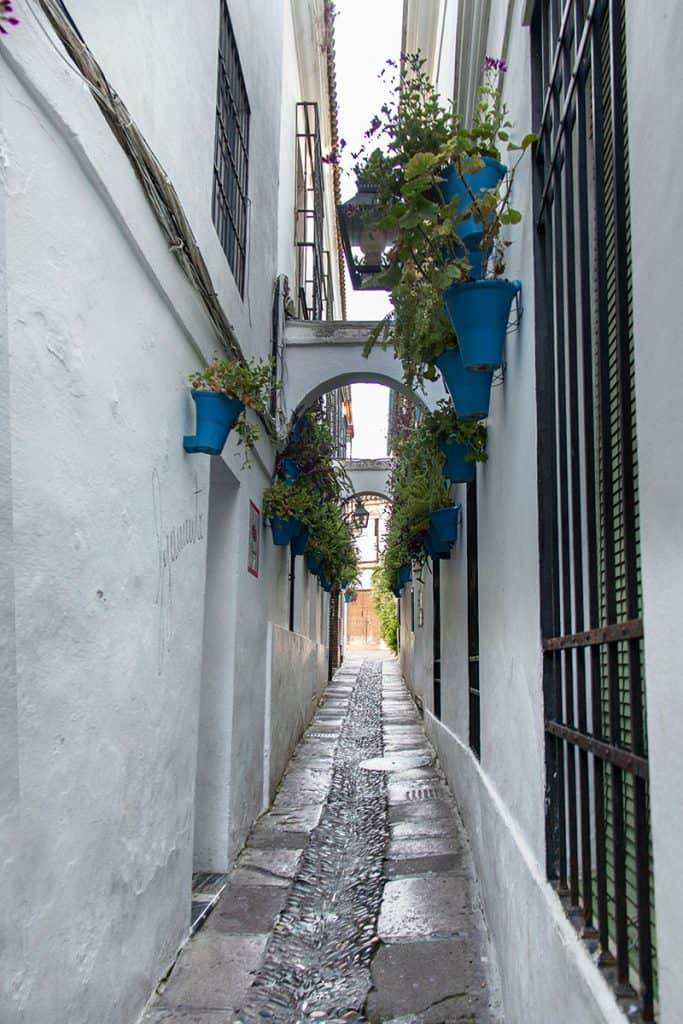
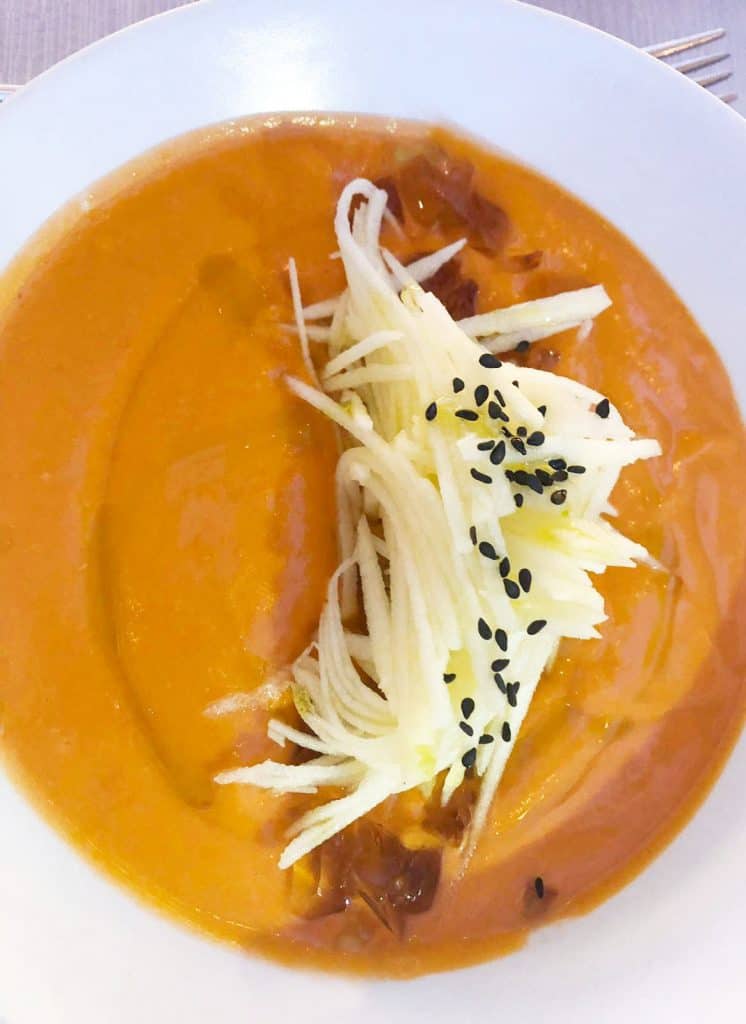
Where to Eat in Cordoba?
There is no shortage of bars and restaurants in Cordoba, some of which are your classic tourist traps, but others are really excellent! Here are recommendations for the best restaurants in Cordoba (well, the ones we managed to visit in 36 hours):
Bar Santos – When in Cordoba, you need to try the local Tortilla de Patatas (Spanish omelet made with potatoes, fried onions, eggs and olive oil) and one of the best places to try this Andalusian delicacy is this bar where you’ll also find several other traditional Andalusian dishes (located at 3, Calle Magistral González Francés, 14003 Córdoba).
Entre Olivos – We loved the food and the great atmosphere here. Try the fresh anchovies on toasted bread, the tuna tartar or any other local delicacy.
Garum 2.1 – This place is kind of an upgraded modern tapas bistro and if the weather is pleasant, ask for a table on the roof so you could enjoy the gorgeous views while tasting the local Salmorejo. All the dishes we tried were great, traditional Andalusian cuisine with a modern twist.
Regadera – We loved the food here! The dishes were tasty and beautiful to look at. Everything is made with fresh, local ingredients and it’s a pleasure to sit in the clean modern and refreshing space. You have to try the Ajo Blanco with wasabi ice cream, their tartar and ceviche were excellent and the desserts were delicious too.
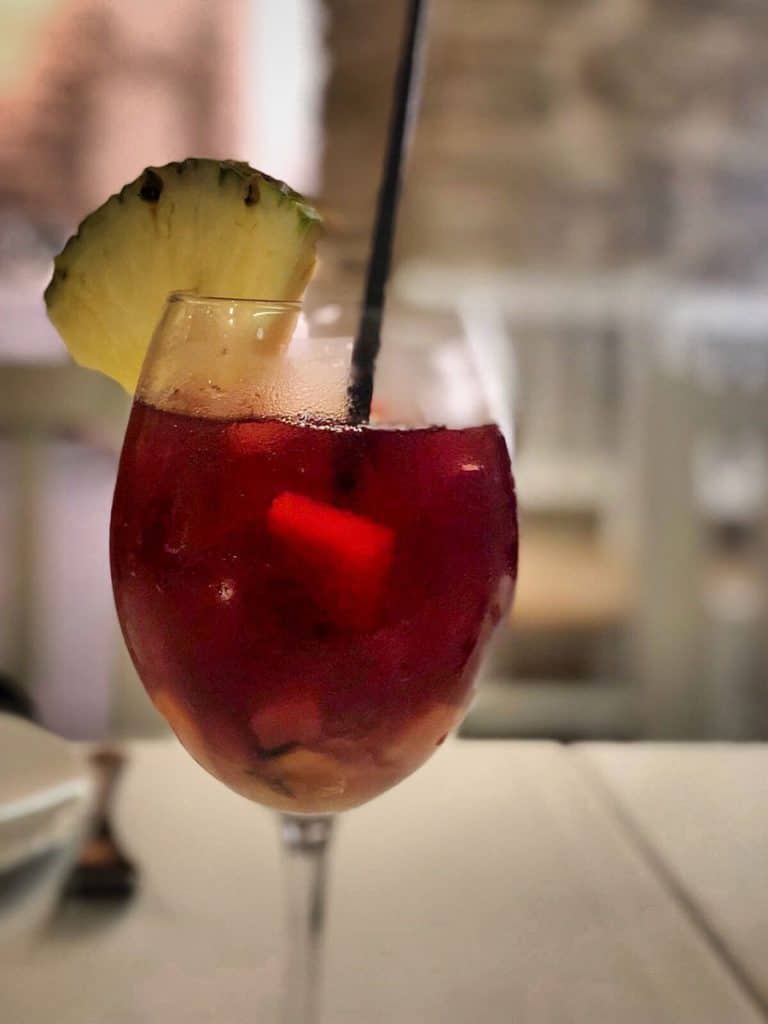

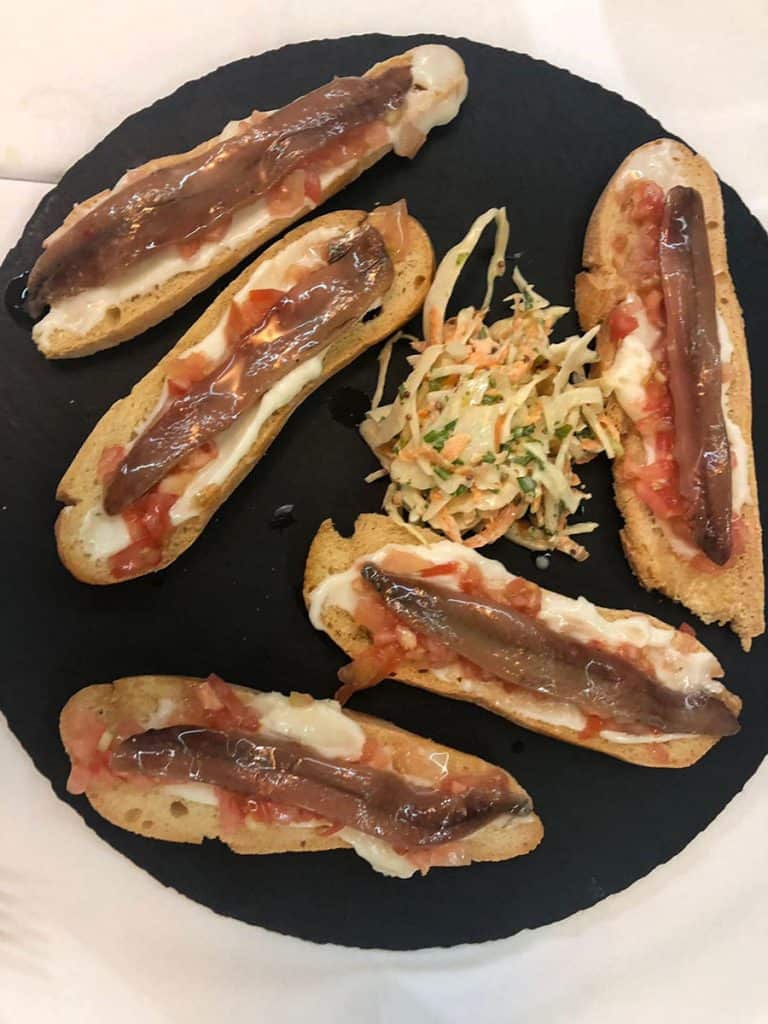
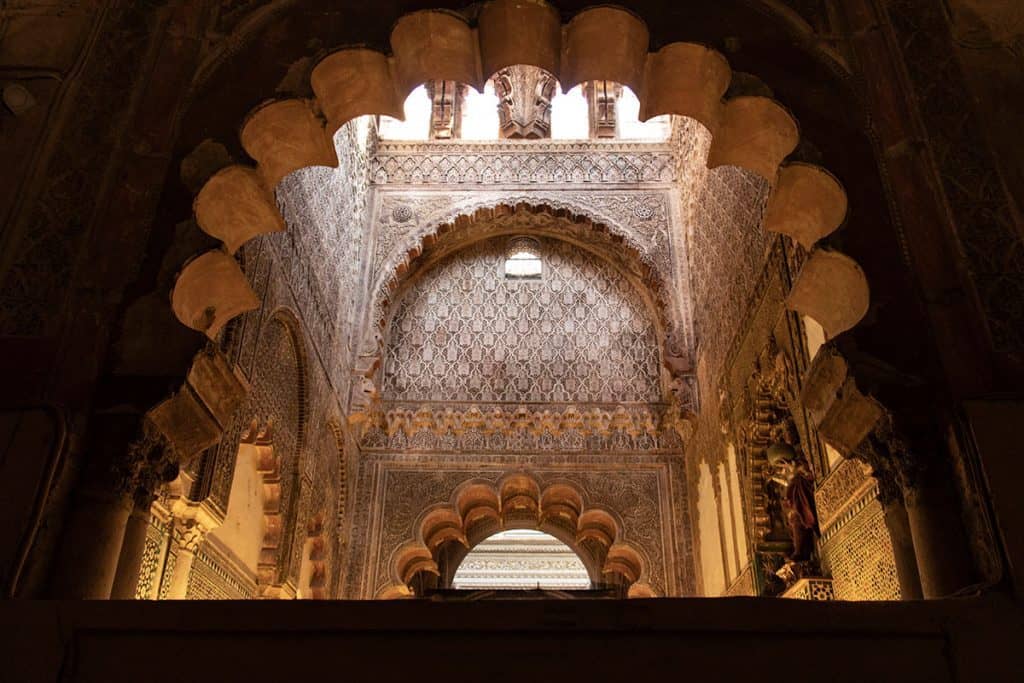
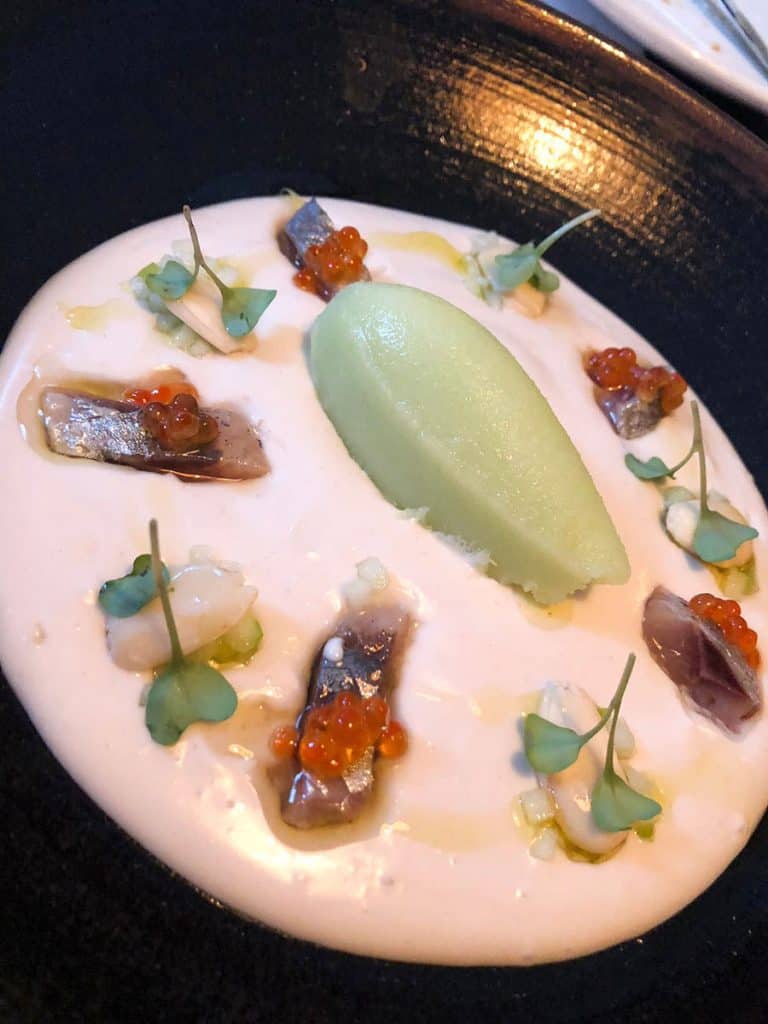
Where to Stay in Cordoba?
If you’re looking for a place to stay in Córdoba, here are some great recommendations you can check out
Luxury: Hospes Palacio del Bailio | Balcón de Córdoba
Mid-Range: Eurostars Patios de Cordoba | Eurostars Palace | NH Collection Amistad Córdoba | H10 Palacio Colomera
Budget: La Boutique Puerta Osario | NH Córdoba Califa
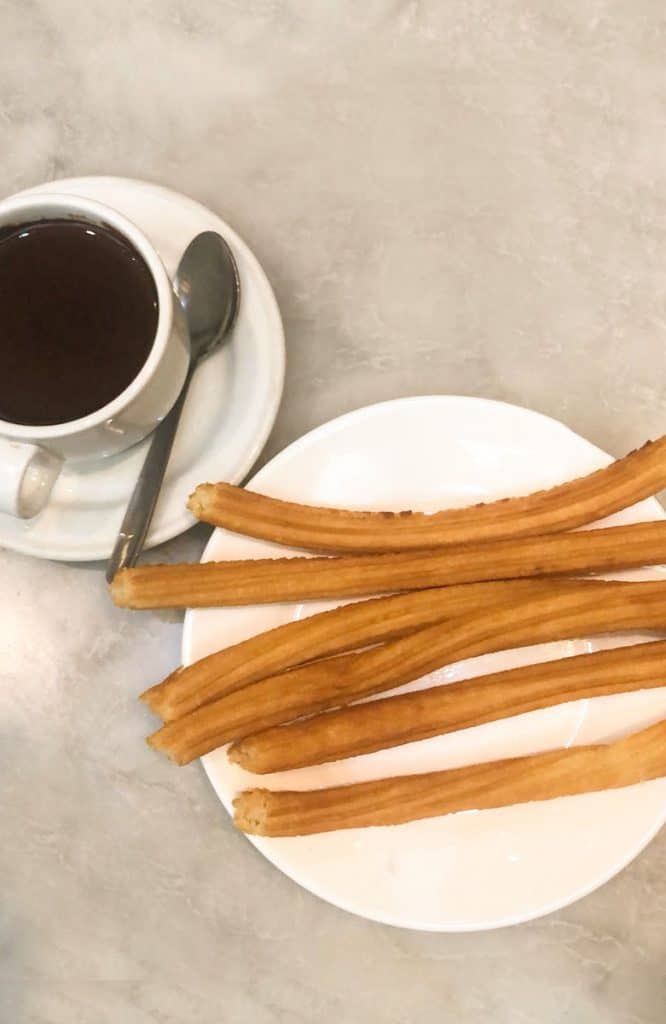
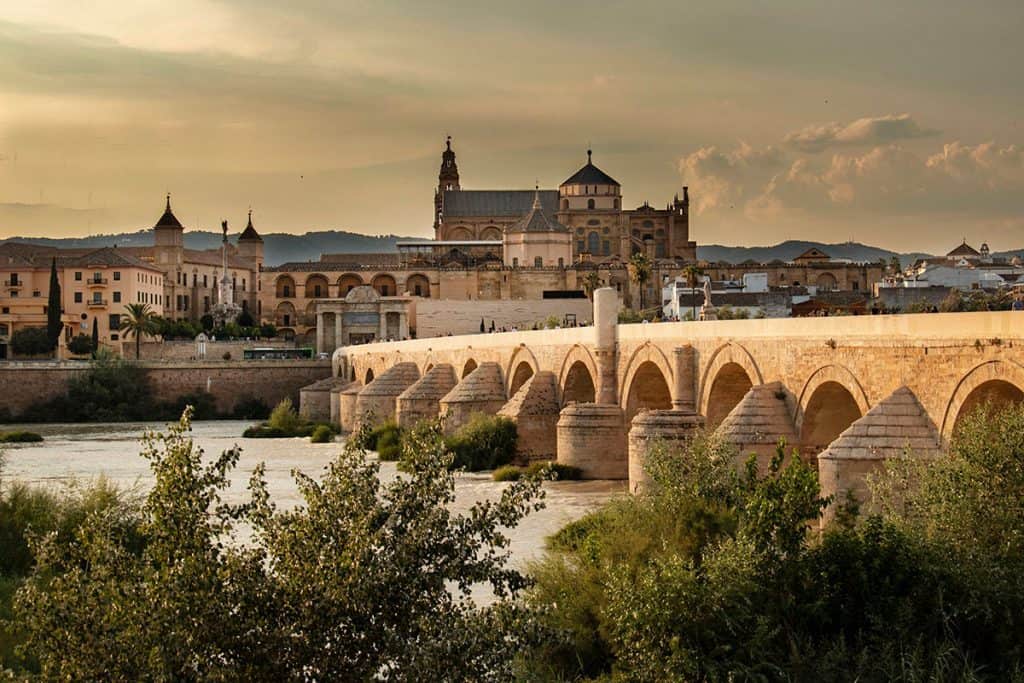
We only had a short time to explore the attractions of Cordoba and from there we continued to sample more Spanish delicacies in Madrid. If you are going to visit Madrid as well, you can check our Foodie Guide to Madrid or our recommendations for the Trendiest Neighborhoods in Madrid.
Don't forget to save it for later!
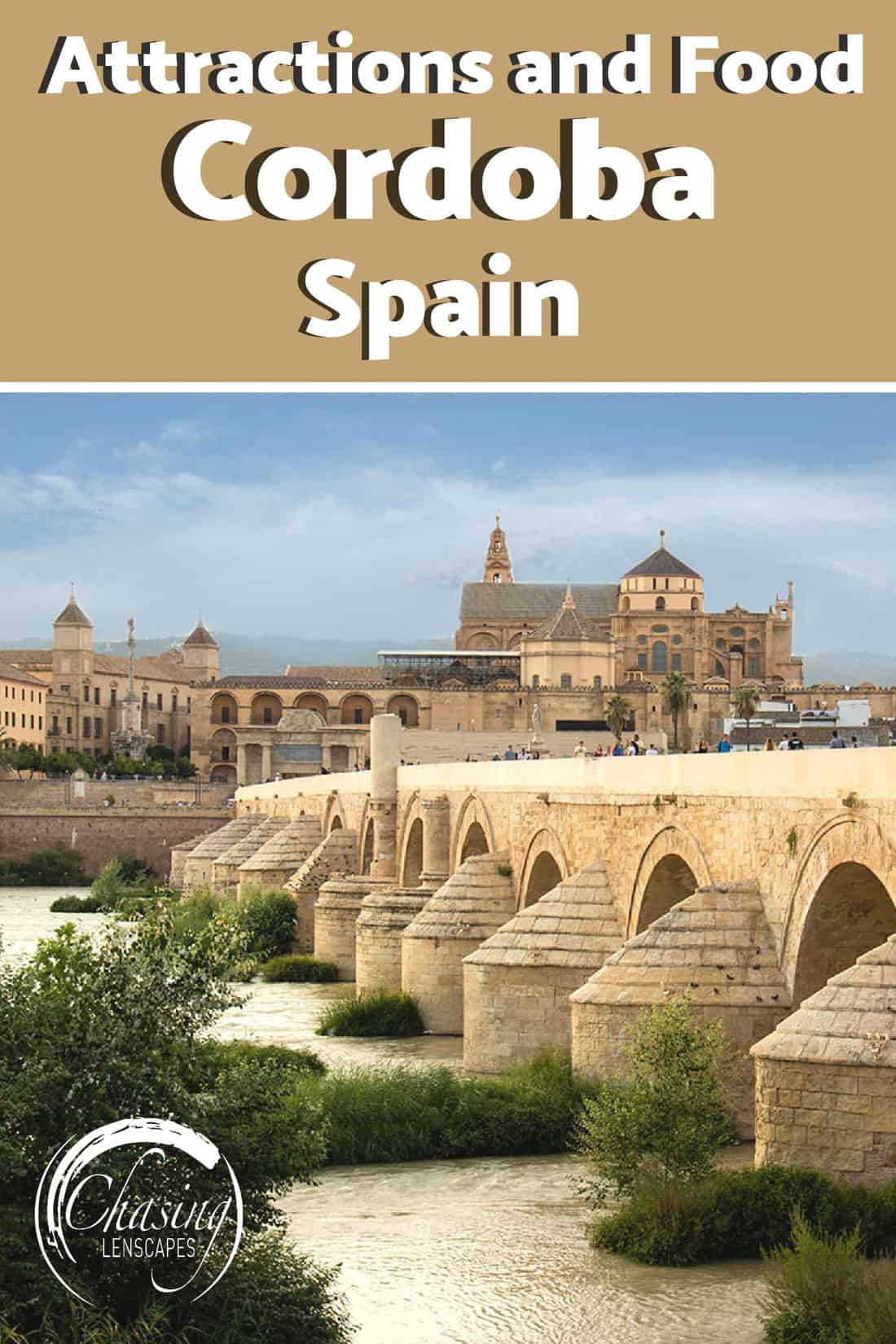
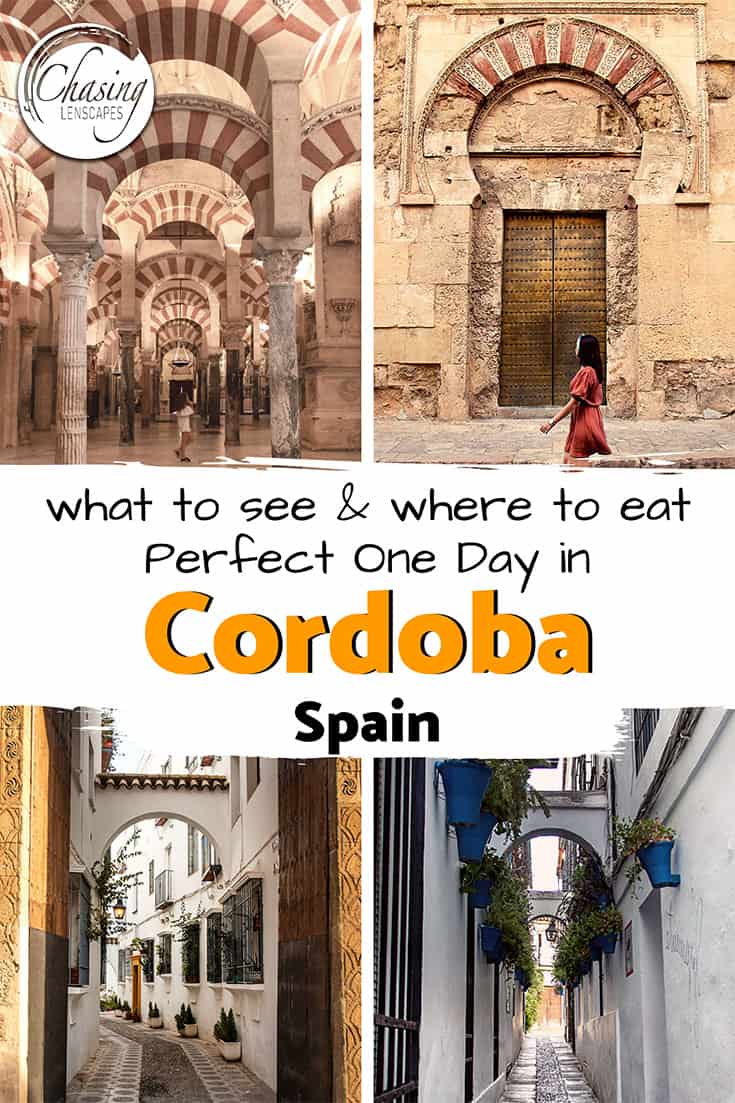
Have you seen our other city guides?
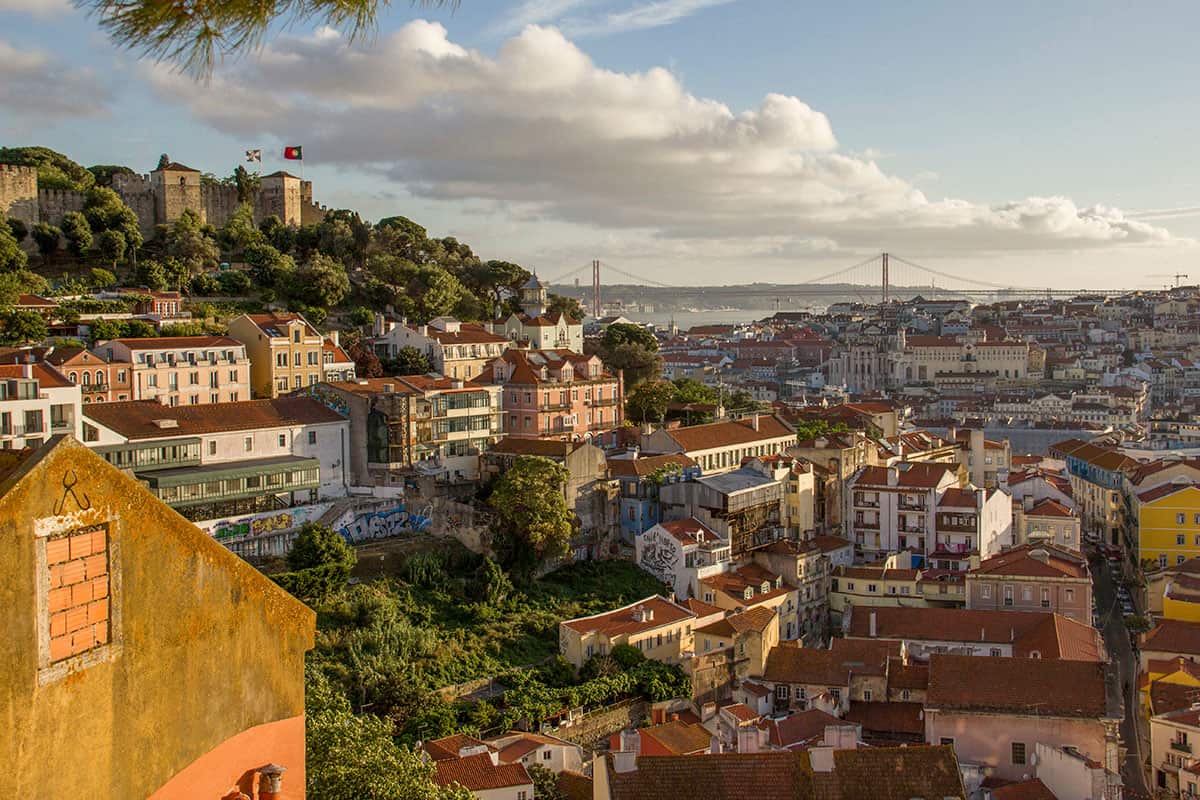
Lisbon Portugal Ultimate City Guide
If you haven't been to Lisbon yet, you'd better book your ticket ASAP. Check out all the best things to do in one of our favourite cities!

Portugal Porto Weekend Guide
Porto is another wonderful city in Portugal that is perfect for a weekend visit. Check out our itinerary for this European city.
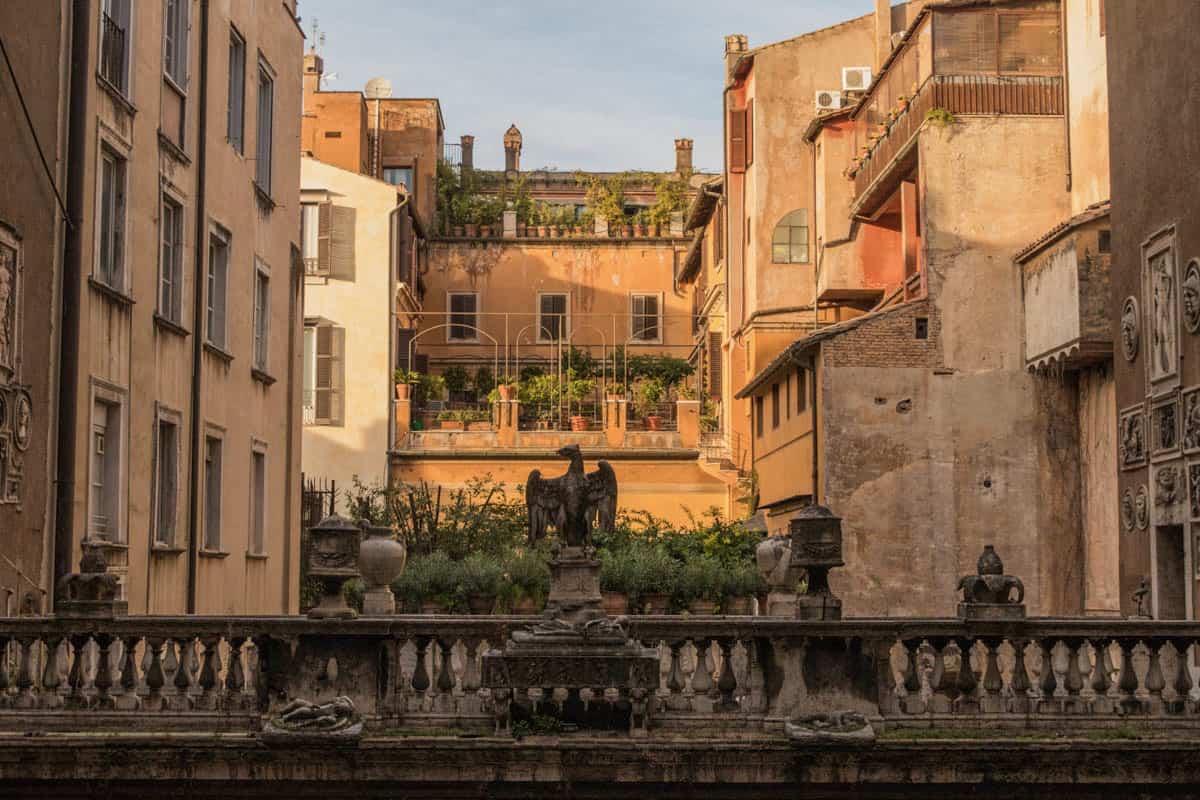
Rome Neighborhoods Guide
Even if you've already been to Rome, these hidden gems will make you fall in love with it all over again.

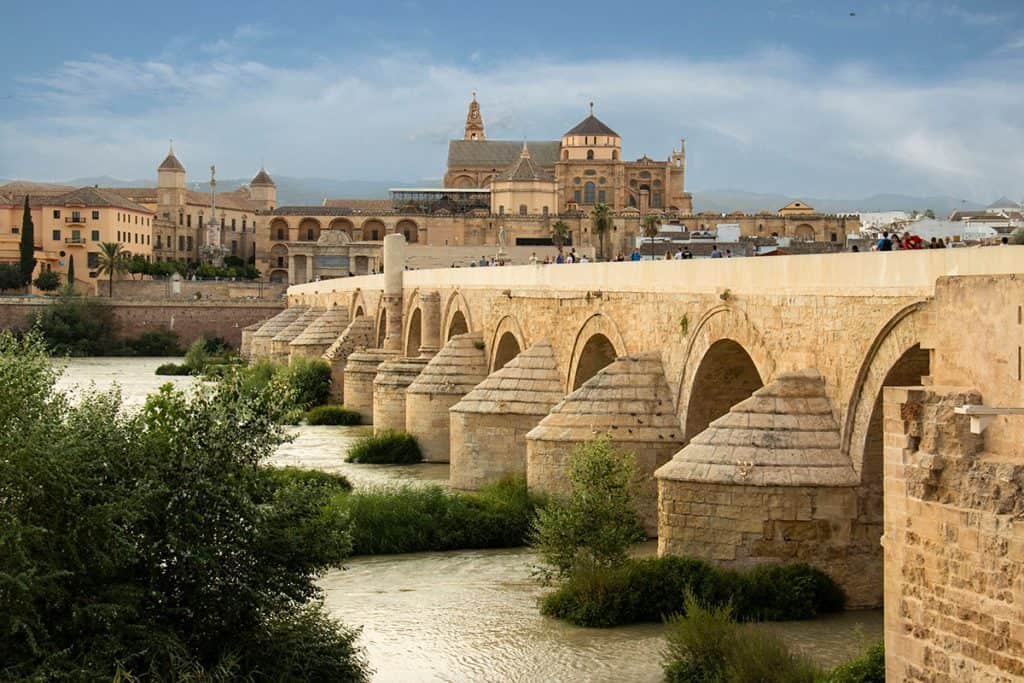
STUNNING photographs! I have been to Cordoba, Argentina, so I think I need to go to the Spanish one to compare! I do love a good Spanish festival!
Thanks so much Georgie! Cordoba is amazing so it was quite easy capturing it with the camera. We would love to go there during the festival season as well! Let’s make a date 😉
These are really wonderful pics! I’ve recently discovered Cordoba and I have to say this post isn’t helping that ache to visit it at all. In a good way, though =D Kudos!
Thanks so much Anna! You should go there when you have the chance. It’s stunning and easy to cover in 2-3 days.
Such a great guide! Spain is also one of my favourite countries and I’ve visited various different parts of Andalusia (including Córdoba) over the years. I love your photos too (and the blog name) 🙂
Thanks so much Kiara. Yes, Spain is close to our heart 🙂
Cordoba looks so different from any place I have visited in Spain! Would love to visit next time I’m in the country!
If you have a chance you should definitely visit it. It is only 2 hours away from Madrid with the fast train. It is really unique!
I’ve not heard of Cordoba, but your photos have me in awe and is now on my list for when I can get around to exploring Spain properly. What a stunning city. And, thanks for advising on the best times to go. Heat and I do not agree. thank you for sharing!
We’d have to disagree on the weather April, though we are not fans of really hot weather, we still prefer it to the freezing cold. Let’s meet up in time for the Spring festivals when the weather’s great and we could join the celebrations 😉 Seriously you should visit Cordoba when you have the chance, stunning and fun!
We were just in Cordoba last month in October as a day trip from Sevilla. It was gorgeous…and still on the warm side! The Mezquita is an amazing place to see….
Great that you made the effort from Sevilla (one of my favorite places in the whole world). The Mezquita is amazing!
Looks beautiful! I was considering visiting during Easter. Do you think it might be a good idea?
Should be great!
This is so great. Thanks so much. You have a great writing style and eye for photography!
We are going there in April.
Cheers!
Thanks so much John and Susan for these great compliments. Glad we could help and have fun!
Even though Spain is a hop, skip and jump from the UK, I haven’t really explored it, but Cordoba sounds beautiful. You might just tempt me to visit!
You should definitely give it a try, we have a feeling you’ll be coming back for more 😉
What beautiful architechture!
I would really love to visit that town some day 🙂
Thanks Ann, we hope you make it!
I always enjoy your photography. Cordoba is so beautiful!!
Thanks so much Cherene, so glad we were able to capture Cordoba’s beauty with our pictures 🙂
Great post – I want to book my ticket now! The patio festival sounds wonderful and I’ll pin this post to refer to your recommendations for where to eat.
Thank you so much Nancy! The patio festival sounds like heaven to us and the Andalusian food is to die for!
I love your blog on Cordoba things to do and see. You have some really good ideas about where to do go, you did a great job. If you are ever in Barcelona I would love to show you some amazing places to eat in the city. I run a food tour company called Eye on Food Tours drop me a line some time.
all the best,
-A
Thanks so much, Adrian. We’re so glad you like it. Don’t worry, we are going to be back in Spain for sure. Thanks so much for your kind offer, we will be in touch!